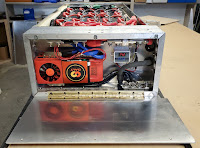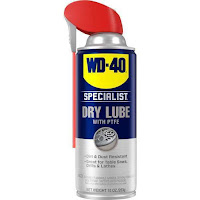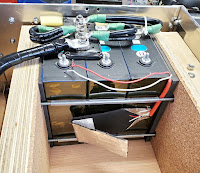The 12V 4S5P 18KWh 'Winter' pack is finally ready. What a beauty 😍
The Poron pads were compressed ~40% with fully charged cells, i.e. in their expanded state. Thereby providing a ~350lb compressive force on each cell as called out by EVE in their specifications discussed here: Constant-Force Lithium Cell Clamping
Compression rod ends:
In case of a rollover accident, the rods will prevent the cells from moving around as they are bolted through the case. Also, the top cover (not pictured) was lined with several layers of insulating kapton tape to prevent the cell terminals from touching the metal in case of a violent shift / crush.
The front enclosure holds the BMS and the cells' temperature controller. It sports large holes on the side and bottom for ventilation, and metal screens to keep insects out:
Weight: 360lbs (163Kg). Each LiFePo4 cell weighs 11.5lbs (5.4kg), for a total of 230lbs (104kg). Can't believe that there is 130lbs (59kg) of cables, BMS, boxes, tray, busbars, fuse, etc. Man, weight adds up fast. As my scale keeps confirming every morning 😅
The previous Leaf's LMO cells weighed 8.25lbs each, for a total of 198lbs. That's 12000 / 198 = 60.6Wh/lb (133Wh/kg), versus 18000/230 = 78.3Wh/lb (172Wh/kg) for the LF280s. Wait, what ? That's upside down !
LiFePo4 is supposed to offer less energy density than Lithium-Manganese / Lithium-Nickel chemistries ! Well, this shows how much progress Lithium cell technology, especially packaging, has made since the Leaf's 24KWh pack launched in... 2011. And since then Nissan's NCM cells from the 40KWh pack have reached 224Wh/kg.
I was afraid that it'd be a nightmare to slide 360lbs in and out of the 'garage' bay, like with the initial 278lbs tray version 1.0 (Nissan Leaf cells, no BMS). But after gluing 2 strips of formica under the tray, and spraying them and the floor rails with some WD40 PTFE (Teflon), the tray can now be moved with just one arm ! Never thought it'd work that well 😅
Diagram:
The controller for the 12V 7W 3x13' heating pads is a basic XH-W3001 device with both a turn-on low temp, and a turn-off high temp, threshold.
While the room and cells were at 12°C (53°F) the controller was set to 13 & 14°C respectively. That brought the cells up to 14°C (57°F) in ~2 hours. Should have no problem keeping the cells warm when finally set to around 5 & 8°C (41 & 46°F).
Consumption while heating is 14V x 2.7A = 38W, and 0.7W when inactive. 24/7 non stop heating would take almost 20 days to deplete the 18KWh pack.
But that will almost never happen as batteries heat up when drawing current. Which, in winter, happens a lot as the space heater regularly turns on to warm up the living space. In other words, except at night or when the van is uninhabited for weeks, heating the batteries will likely be a marginal occurence.
Turning on the Daly BMS was a pain in the hyoid bone, as reported in many user forums: bluetooth not working, BMS going to sleep after only minutes while in the middle of setting it up via a PC, inconsistent or non-working 🟥 / 🟨 / 🟩 flags when changing settings, no detailed doc on each setting, poor manuals / docs / videos, etc. 😒
Nothing insurmountable though and, finally, the beast is now ticking !
Alas, a major issue surfaced: the configuration software limits the inputted capacity to 1000AH per cell. But this van's 4S5P Winter pack is 5 x 280 = 1400AH per cell. Meaning that the BMS's minimum-SOC protection might shut off the pack after only 71% of its capacity has been used ? Contacting Daly to see if that protection can be disabled or fooled... 🙏
Might be able to fool it by scaling its 'current measuring resistance' setting from the factory's 0.05mΩ up to 0.05 * 1.4 = 0.07mΩ, and adjusting all the current parameters accordingly. That'd be a sweet hack, better than losing ~$900 worth of capacity and wiring.
Update 1st round reply: "Our engineer told me that this operation is not acceptable. If it exceeds 1000AH, the program can only be modified before leaving the factory. But soc will not trigger the protection function of BMS". This is good news as the SOC settings seem to be just useless warnings, not providing actual protection. But it is also bad news as many of the customizable settings above may actually only trigger warnings but no protection. What's the use for warnings if the pack is left unattended for days ? In the process of clarifying with Daly...
Update2 Per Daly's support only the VCell & VSum & Temp settings on the Lvl2 line (bottom of the table above) are protections. Plus the Short Current value. Meaning that, if reached, the BMS will actually react and shut off the pack. All others, on Lvl1 or Lvl2, are just warnings. Which are not recorded by the BMS, and can be seen only if a PC or BT device is constantly connected. In other words: pretty useless in everyday use outside of testing.
Oh well, still pretty relieved that the SOC state can not trigger a protection event. And having Temp protection was critical, seeing the intended travel in very cold & hot areas. So this BMS will work for this camper van application, yay 👍
Note that, under load, the BMS's measured current was quite off compared to the ampmeter and to the Victron Smartshunt. So I adjusted its Current Sampling Resistance setting from 0.05mΩ to 0.06345mΩ. But the current threshold values were left as is since they are way above the values expected in our use case.
Now that this multi-months build is finally done, what would I do differently next time ? Mostly just replace the dual-4AWG flexible busbars by rigid 4 x 20mm (~ 3/16 x 3/4") busbars. Cells expand in width, not in length, during charging. So, due to this pack's specific layout, there is no real need for busbar flexibility between the 1S pools. That would save a lot of build time, and provide a slightly lower resistance.
Still no shower in the van, but it will at least have heat for the Ouray trip in 10 days, yay ! 😅
Update - Mar'23 Based on the learnings from the winter trip in Ouray, the 'Winter' battery pack was downsized as a gasoline heater will now provide heat for the living space. The 12V space heater will be kept around to provide backup heating, if need be, and silent mild heating during the inter-season.
Since only lights, cooking and water heating are left as the main electric loads (and AC in Summer), 10KWh should be sufficient for more than a week of use. So the 18KWh 4S5P pack was reconfigured as 10KWh 4S3P.
New pressure plates were built:
Removing the self-adhering heating pads from the cell sides was a mess. Should have just installed them with the original anti-stick tape still on. Applying aluminum foil HVAC tape took care of that before re-installing them:
The number of pads was also reduced from 4 to 2, seeing how efficient they were before at bringing the cells up to temp, and as 8 cells were removed and better insulation used.
Here are the final BMS settings:
And voila, a much lighter ~255lbs (116Kg) 10KWh pack:
The complementary 'Summer' pack will not be needed anymore. So 20 EVE LF280 (280Ah) cells will be up for sale soon ! 💲💲💲
____________________________________














.jpg)

Comments
Post a Comment